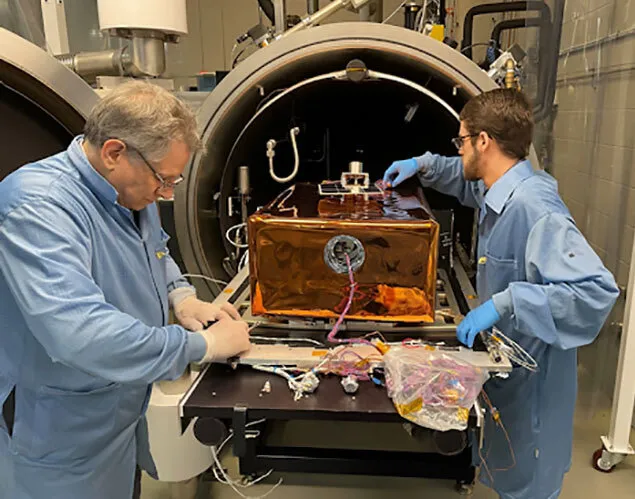- April 11, 2024
- By Georgia Jiang
An instrument to detect “moonquakes” developed in part by a University of Maryland geologist is among the scientific equipment recently selected by NASA for its planned return of astronauts to the moon.
Once installed near the lunar south pole during the Artemis III mission—the first human visit to the moon’s surface in more than 50 years—the Lunar Environment Monitoring Station (LEMS) will collect valuable seismic data about the lunar environment and its interior and help prepare NASA to establish a long term presence on other planetary bodies.
“This means being patient and listening for moonquakes, which can be caused by things like impacts hitting the moon or internal quaking from deep inside the lunar interior,” said Associate Professor Nick Schmerr, deputy principal investigator of the LEMS project. “With enough seismic events, we’ll be able to use our tools to study the moon’s deeper structure.”
Led by University of Maryland, Baltimore County (UMBC) planetary scientist Mehdi Benna, the LEMS project is the result of a yearslong collaboration between UMBC, UMD, NASA’s Goddard Space Flight Center, the University of Arizona, Morehead State University and Washington University in St. Louis.

The size of a small suitcase, the seismometer package will also analyze the regional structure of the moon’s crust and mantle, which will add valuable information to lunar formation and evolution models. LEMS is intended to operate on the lunar surface for up to two years and may become a key station in a future global lunar geophysical network, providing vital information for future space missions.
“Artemis III will be visiting a location on the moon unlike any visited by Apollo, and as such, we don’t have many details about the thickness of the crust and what the mantle looks like,” Schmerr said. “LEMS will give us additional insight into what’s going on in the moon’s subsurface.”
When scientists first started working on the LEMS project in 2018, the research team realized that technology headed to the lunar surface had to be durable enough to survive the moon’s harsh conditions for a long period.
“The lunar environment is one of the harshest environments in the solar system because it rotates very slowly around itself—daytime on the moon lasts about 15 Earth days, and night on the moon lasts 15 Earth days,” Benna explained. “Because the moon doesn't have an atmosphere, the days are very hot and the nights get really cold.”
With careful engineering, the researchers developed methods and tools to keep LEMS safe, intact and relatively self-sustaining—all while staying as power-efficient as possible.
“We constructed ways to reduce or eliminate heat pathways away from the internal electronics,” Schmerr said. “For example, we plan to have the LEMS package isolate itself from the ground with a set of skids underneath and have a series of thermal blankets around the exterior that will keep extreme temperatures out and reduce the need to run energy-draining heaters during the night. We also plan to keep our seismometers safe by burying them because even 10 centimeters of overlying lunar soil can help insulate them from the lunar day and night cycles.”
The station’s battery is designed to self-charge using power stored by its solar panels during the day to keep the station operational at night. The LEMS instrument is expected to autonomously beam its data to one of NASA’s Deep Space Network ground stations once a month via its own communication antennas and radio system.
With the data retrieved from LEMS’ two seismometers, the team hopes to learn the structure of the local crust and mantle—and gain unprecedented insight into the moon’s evolutionary history, as well as the intricacies of planetary formation.
“Artemis III is the Apollo 11 of our generation—that’s significant. Landing astronauts on the moon doesn’t get any easier 50 years later,” Benna said. “Being a part of this adventure is extremely exciting.”
As deputy principal investigator for the project, Schmerr will coordinate interactions with the larger Artemis III ScienceTeam, and will support development of a concept of operations for instrument deployment. He believes that NASA’s return to the moon and LEMS’s arrival on the lunar surface is the first step into a new era of lunar seismology and space exploration.
“The work we’ve done here to develop LEMS has helped us hone our ability to create technology that’s low-power, compact and durable while staying effective. We’re also learning much more about the worlds beyond Earth,” Schmerr said. “It’s all laying the groundwork for more opportunities to explore planets like Mars and beyond.”
This article was adapted from text provided by NASA and UMBC.
Topics
Research